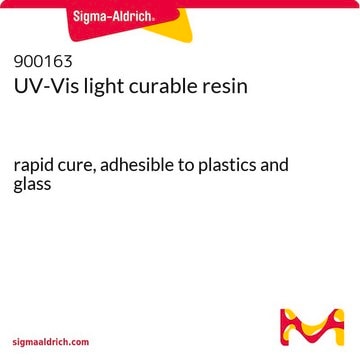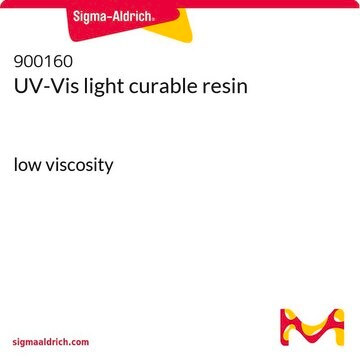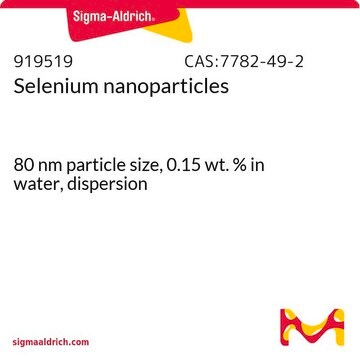925551
Ultracur3D® ST 45
About This Item
Prodotti consigliati
Caratteristiche più verdi
Design for Energy Efficiency
Use of Renewable Feedstocks
Learn more about the Principles of Green Chemistry.
Livello qualitativo
sustainability
Greener Alternative Product
Categoria alternativa più verde
Descrizione generale
Applicazioni
1) Preparation of resin - The material should be processed at room temperature. Before usage the material should be shaken well. Pour it slowly in the vat and wait a couple minutes, until smooth, bubble-free surface is obtained before starting the print job.
2) Printing process - As the suitable 3D printer examples and setting parameters stated above are only for general guidance purpose, user should always define the optimal settings according to nneds and printer.
3) Removing parts - Remove the parts carefully from the build platform with a suite able tool, for more information see the Instruction for Use of the used 3D-printer.
4) Cleaning process - The printed pieces can be cleaned firstly immersing it in glycol ether based solvent in an ultrasonic bath filled with water for 2 minutes, followed by rinsing with 2-propanol for a few seconds. Fine structures or holes may be better cleaned by using 2-propanol and a syringe or by separate brushing. The parts should be placed afterwards in a container filled with fresh 2-propanol and subsequently treated in an ultrasonic bath filled with water for 2 minutes. Blow dry the parts with pressure air/nitrogen, until the parts are clean.
5) Drying - Place the parts into a warming cabinet at 40 °C for 30 minutes.
6) Post-curing - The parts require adequate post curing to achieve the optimized final mechanical properties. After each post-curing cycle, the part needs to be flipped to achieve an even curing.
These proceedings are only general guidelines, the optimal printing settings as well as curing time must be defined by the user himself. The post-curing might differ by using different 3D-Printers and different post-curing units may require different settings.
SLA can be used to create highly complex prototypes with a smooth surface finish. It offers high surface finishing and accuracy, while perfect for printing very large parts.
DLP is your go-to method when opting for a quick printing process without compromising on the quality of intricate parts. It provides high productivity, and can be used for larger and smaller parts.
LCD provides the opportunity to replace low and medium series injection molds with large parts. One of the biggest benefits of printing with Liquid Crystal Display (LCD) is to enable economic and large-scale production.
Testing conditions Ethylene Oxide Sterilization:
- Preconditioning temperature 48 °C
- Preconditioning humidity 60 %
- Preconditioning time 8 hours
- Chamber temperature 45 °C
- Vacuum 75 mbar A
- EO dwell time 3 hours
- EO concentration (calculated) 610 mg/l
- Postconditioning time 48 hours
- Postconditioning temperature 45 °C
The product is designed for fast and accurate additive manufacturing and possesses the following characteristics:
- Viscosity (30C): 210 mPas (cone/plate rheometer)
- Density (liquid resin): 1.12 g/cm3 (ASTM D4052-18a)
- Density (printed part): 1.2 g/cm3 (ASTM D792)
3D printed parts exhibit the following properties:
- E Modulus: 2300 MPa (ASTM D638)
- Tensile Strength: 60 MPa (ASTM D638)
- Elongation at break: 25 % (ASTM D638)
- Impact Strength (notched): 20 J/m (ASTM D256)
- HDT (0.45MPa/1.82MPa): 73C/61C (ASTM D648)
- Hardness Shore: D 88 (ASTM D2240)
Note, these properties may vary based on the 3D printer used, thickness of printed layers, exposure duration per layer, as well as post cure method and its duration.
Stoccaggio e stabilità
Keep container tightly closed in a room temperature (below 30 °C and above 0 °C) and resin away from light. Keep container dry. If Material is not being used fill it back through a filter in the corresponding material bottle. The filter prevents to fill cured pieces or failed prints back into the bottle. Ultracur3D® ST 45 must be disposed of or incinerated in accordance with local regulations.
Note legali
Avvertenze
Danger
Indicazioni di pericolo
Consigli di prudenza
Classi di pericolo
Acute Tox. 4 Oral - Aquatic Chronic 3 - Eye Dam. 1 - Skin Irrit. 2 - Skin Sens. 1 - STOT RE 2 Oral
Codice della classe di stoccaggio
10 - Combustible liquids
Classe di pericolosità dell'acqua (WGK)
WGK 3
Certificati d'analisi (COA)
Cerca il Certificati d'analisi (COA) digitando il numero di lotto/batch corrispondente. I numeri di lotto o di batch sono stampati sull'etichetta dei prodotti dopo la parola ‘Lotto’ o ‘Batch’.
Possiedi già questo prodotto?
I documenti relativi ai prodotti acquistati recentemente sono disponibili nell’Archivio dei documenti.
Il team dei nostri ricercatori vanta grande esperienza in tutte le aree della ricerca quali Life Science, scienza dei materiali, sintesi chimica, cromatografia, discipline analitiche, ecc..
Contatta l'Assistenza Tecnica.











